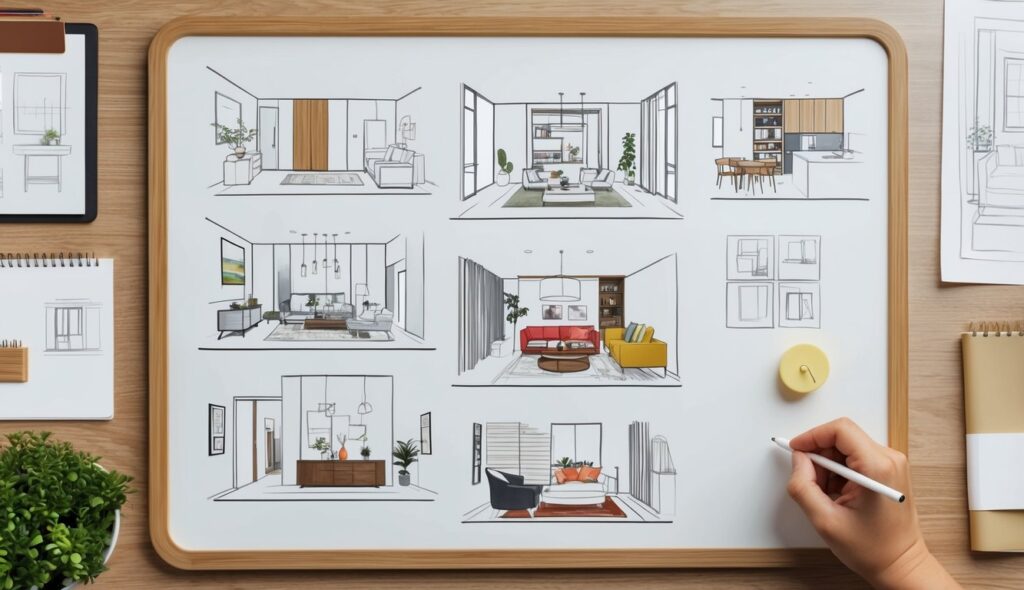Custom blinds are an essential component when working with unique architectural features.
Remember to repin your favorite images!
These specialized window treatments are designed to fit seamlessly into distinctive shapes and sizes, enhancing the overall aesthetics and functionality of a space.
Architects and interior designers can transform a space by integrating well-crafted custom blinds into their designs, making use of advanced materials and tailored solutions for optimal light control and privacy.
The realm of custom blinds covers a vast array of options, from triangular blinds designed for uncommon geometries to arched window coverings that highlight the elegance of semicircular windows.
The precise fit and superior quality of custom blinds surpass standard, ready-made options, providing a durable and sophisticated touch to any architectural project.
Selecting the right window treatments can significantly influence the atmosphere of a room, balancing natural light with the desired level of privacy.
Inspiration for custom blinds can arise from various architectural elements, whether integrating them into bay windows, circular windows, or any other unique design features.
Thoughtful consideration of materials, colors, and styles ensures that window treatments complement the overall design while enhancing the functional aspects of the space.
With the right choices, architects and designers can create harmonious interiors that not only meet the practical needs but also reflect the distinct character of the architecture.
Evaluating Custom Blinds for Unique Windows
Selecting custom blinds for unique windows involves understanding the specific window features, considering material options for durability and style, and ensuring the balance between functionality and aesthetics.
Identifying Window Features
Unique windows often include features like arches, circles, triangles, and angles.
These architectural elements add character but can complicate finding standard window treatments.
For instance, triangular windows can be challenging due to their non-rectangular shape. Similarly, skylights require blinds that can stay in place on a slanted surface.
Identifying these features early is crucial in choosing custom blinds that can seamlessly fit and enhance these special windows.
Material Considerations for Durability and Style
The choice of material is vital for both durability and style.
Common materials include wood, vinyl, and aluminum.
For example, wood offers a classic look but might not be ideal for humid areas.
Vinyl, while sturdy, can provide a variety of colors and finishes. Aluminum is lightweight and durable, perfect for modern settings.
Each material also influences energy efficiency and light control, which can impact a room’s overall comfort.
Functionality Meets Aesthetics
When evaluating custom blinds, it’s important to consider how their functionality can enhance the room’s aesthetics.
Blinds like Keego Zebra Blinds offer dual-layer designs that provide both sheer and opaque options for better light control and privacy.
Custom options allow for specific designs to fit odd-shaped windows while maintaining a cohesive look.
For instance, cordless options like Keego Blinds provide a sleek, modern appearance without the tangle of cords.
This ensures that the blinds not only fit well but also contribute to the overall design vision.
Custom Blind Design and Installation Process
Custom blinds add sophistication and functionality to any architectural feature.
Key aspects of the custom blind design and installation process include choosing the right treatments, obtaining precise measurements, and ensuring professional installation with a warranty.
Choosing the Right Custom Window Treatments
Selecting the right custom window treatments involves evaluating the specific needs of the space.
Options include roller shades, shutters, and motorized blinds.
Attention should be given to the architectural feature of the window, such as its shape and size.
Material choices range from wood and faux wood to metal and fabric.
Each material offers unique benefits and aligns with different design aesthetics.
For instance, cellular shades provide excellent insulation, making them ideal for energy-efficient buildings.
Design consultants play a crucial role in helping to match the blinds to the interior design style.
They consider factors like light control, privacy, and ease of use.
Custom blinds should not only complement the design but also function optimally within the space.
Professional Measurement and Consultation
Accurate measurements are essential for ensuring a perfect fit.
A free in-home consultation usually includes precise measuring of each window.
This is especially important for non-standard window shapes like triangular or arched windows, which require custom solutions.
During the consultation, experts assess the installation area and offer advice on the best types of blinds for the architectural feature in question.
They also discuss potential challenges and how to overcome them, ensuring the final product meets expectations.
Accurate measurements prevent issues such as light gaps or improper fitting, which can detract from the overall aesthetic and functionality.
Installation and Warranty
Professional installation guarantees that custom blinds are mounted correctly, ensuring longevity and optimal performance.
Installers follow best practices to ensure the blinds are secure and function smoothly. This step is critical, as improper installation can lead to operational problems and reduce the lifespan of the window treatments.
A warranty typically accompanies custom blinds, providing peace of mind.
Many companies offer a limited lifetime warranty, covering defects in materials or workmanship. This warranty ensures service satisfaction and can include future maintenance.
By ensuring professional installation and robust warranty coverage, architects can confidently specify custom blinds, knowing they will enhance both the appearance and functionality of any space.

